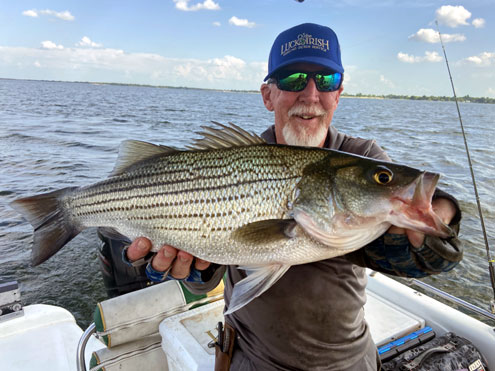My first experience with using downriggers for stripers and hybrid striper occurred 30 years ago. I was fishing with a very experienced guide that specialized in using downriggers, a very effective method of trolling lures at a specific depth using a heavy metal ball to maintain the proper depth. This was back in the day before GPS and modern sonar. Through trial and error the guide had plotted out courses to troll that were void of underwater structure that could play havoc with the downrigger ball. There is no telling how many costly downrigger balls he had lost while plotting the “safe” routes to run his boat.
Just last week, I fished Lake Tawakoni with guide Omar Cotter, Luck O’ The Irish Guide Service. Omar employs the best fish catching techniques for the season and right now, he is depending upon his downriggers to put is clients on some of the lakes hard fighting hybrid stripers and an occasional striped bass.
On the phone before our trip, I was given a briefing on what to expect.
"Luke, we can troll Hellbenders (deep diving crankbaits) with Pet spoon trailers and catch all the sandbass we want," Omar told me, "but, later in the afternoon and during early morning, hybrid stripers have been stacking up on some of the lower lake humps and this is where downrigging with soft plastics has been paying big dividends. What you say we hit the water around 4 in the afternoon and do some catching?"
I was all in with the word ‘catching’!
It had been many years since I did any downrigging and I was ready to see how the technique has progressed since I last tried it back in the nineties. My friend Jeff Rice who produces our weekly TV show “A Sportsmans Life” met Omar and I at the dock with his video camera to hopefully catch some fish and record the action for this week’s show.
Omar soon had the bow of his comfortable center console Fishmaster pointed in a southerly direction, toward some deep water out from the dam. Back to the north we noted clouds building and made mental notes to keep an eye on the radar, we would be fishing several miles from Tawakoni Marina and had no plans that included dealing with the pop-up storms and the lightning they often produce. High wind is something that can usually be dealt with assuming one is in a big safe craft but lightning is an entirely different animal. We all had spent a lifetime outdoors and seen firsthand the deadly effects of lightning.
It’s didn’t take long to arrive at Omar’s honey hole and the storm seemed to be heading to the southwest. Optimism was high as Omar marked a valley between two submerged ridges and began studying his sonar. Soon a big school of fish plotted on the screen, Omar could tell they were hybrids by their signatures on the graph. A definite thermocline is established now and fish cannot survive in the cooler, low-oxygenated waters below. A thermocline actually plots on sonar as a false bottom and makes finding fish easier; it eliminates everything below the line.
The school was marked on GPS and we made a circle. With both downriggers keeping baits about 1.5 feet about the school, we trolled our baits into the fish. On the first pass, the rod nearest me twitched once and the line was disengaged from the downrigger. I found myself solidly hooked to one of the hardest fighting fish in fresh water, a chunky hybrid striper. This was no lake record but a solid 5-pounder that would make fine dining. I absolutely love eating hybrid striper that is either blackened or broiled with butter and dry seasonings.

A glance back to the north and a check of radar indicated the storm was now heading more to the east and would probably arrive at the marina in thirty minutes or so. We continued with our downrigging program for few more minutes and succeeded in getting some great footage of our upcoming TV show. Luckily, the storm was moving slowly and we had time to do some white bass trolling with the Hellbenders and Pet Spoon trailers. Just as predicted, the sandbass catching was fast and furious. But common sense prevailed and after boxing a few fish, we all concurred it was time to think safety. It was hammer down all the way back to the marina. We arrived well in advance of the storm, giving Omar time to turn our catch into some tasty fillets.
This trip was far different than the times I remember downrigging three decades ago. Thanks to GPS and state of the art sonar, our guide was able to keep those downriggers and baits precisely over the fish. Trees and obstructions that would cause havoc were showing up on the graph and easily avoided. Omar likened fishing with downriggers to rifle shooting.
“With the downrigger balls we are precisely positioning our baits right where we want them to be, just like shooting a tight group with a rifle," he explains. "But trolling with the Hellbenders through the huge sandbass schools is different, more like shooting a shotgun. There are so many sandbass down there our baits just needs to be running at the proper depth."
As I pulled away from the Marina, the leading edge of the storm remained with me all the way home. Lightening was popping and traffic was moving at a crawl thanks to the torrential rain. The afternoon was a huge success thanks to the experience of a veteran guide that knows how to get it done and also when to think safety!
Join me on Saturday, August 2 at 3:30 p.m. at the Terrell, Texas, airport for a hunting seminar with several knowledgeable speakers. Location is the BFTS Museum. For more information, visit www.bftsmuseum.org
Contact outdoors writer Luke Clayton through his website www.catfishradio.org

